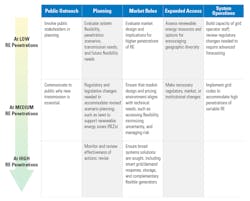Expedite Energy Transformation by Adopting Proven Practices
In November 2018, the European Commission adopted a strategic long-term vision for a prosperous, modern, competitive, and climate neutral economy by 2050.
Wide-scale energy transformation is central to realizing this vision. As part of this vision, power systems must evolve rapidly to improve energy access, bolster energy security, increase economic opportunity, and build resilience.
But this endeavor isn’t easy. EU member states and many other countries and subnational jurisdictions are committed to transforming their power systems and incorporating higher penetrations of renewable energy (RE) generation. And that must be achieved without interruption of service—a feat similar to rebuilding a plane midflight.
Globally, pioneers on the path to energy transformation have succeeded in integrating groundbreaking levels of variable RE onto their grids. The pioneers reflect diverse geographies, markets, and power systems. And they have applied myriad mechanisms for managing high penetrations of RE, ranging from faster markets to flexible operations of generation, both conventional and RE.
Although their approaches vary widely, common lessons have emerged from their collective experience. Applied research by the U.S. Department of Energy’s National Renewable Energy Laboratory and other leading institutions has been pivotal to the success of many of these efforts over the past decade—and this support has given rise to a proven set of best practices and frameworks for success.
As leaders in government, utilities, system operators, business, and civil society work to develop and implement their 2050 visions, working synergistically across the following five proven key precepts of effective planning and system transformation will help realize goals.
1. Lead Public Engagement Particularly for New Transmission
Securing the buy-in of stakeholders with diverse priorities, interests, and values is a critical first step to advancing any transformation of the power system—particularly if changes require new transmission infrastructure.
Stakeholders may raise concerns about costs, land use changes, environmental impacts, decreased property values, or health impacts. Confronting such issues proactively through an open exchange of information among key stakeholders is foundational to public planning.
Although transmission expansion can be one of the biggest challenges to accessing new sites for RE generation, public engagement presents an invaluable opportunity to address concerns, encourage compromise, communicate project goals and benefits, and garner support.[1]
2. Coordinate and Integrate Planning
Planning comprises an inherently complex set of activities undertaken by multiple groups and jurisdictions for a given power system. Deftly navigating the dynamic interplays and interlinkages among them is the signature challenge for planners and policymakers.
Succinctly, power systems with high penetrations of variable RE and distributed energy technologies such as storage can be accommodated by integrating the planning of generation, transmission, and system performance and modifying investment frameworks, market rules, and grid codes to expand technology access and unlock financing. Further efforts such as establishing partnerships among a network of public and private institutions and stakeholders and syncing local and regional planning to better relay and coordinate information across jurisdictions can also help facilitate integration.[2]
Many are familiar with Denmark’s commitment to 100% RE and the synergies among its leaders, system operators, neighboring countries, market regulators, civil society and technology companies. Another example, perhaps less familiar is the Hawaii Clean Energy Initiative.[3] Within a decade of launching the initiative, the state established itself as a world leader on energy transformation by supporting institutional capacity to increase integration and coordination of energy system planning, visualizing the impacts of moving from analyses and recommendations to actions, modifying grid codes (rules that govern how power plants connect to and support the grid) and other operational considerations, and sharing best practices and guidelines for adapting advanced planning capabilities.
3. Develop Rules for Market Evolution that Enable System Flexibility
The benefits of a flexible power system that can balance electricity supply and demand across all timescales range from ensuring instantaneous system stability to supporting long-term supply security. While options such as power plant retrofits, battery energy storage, and demand-side management programs can help promote flexibility, global experience suggests flexibility can be enhanced without major capital investments.
Encouraging market and system operators to adopt rules to enable faster and more flexible operations (e.g., switching from hourly to five-minute operations), providing a regulatory process to modify generation contracts to better value flexibility, and negotiating frameworks for cross-border electricity trades that optimize flexibility across regions are all ways to help unlock inherent, often underutilized system flexibility.
4. Expand Access to Diverse Resources and Geographic Footprint of Operations
Expanding access to geographically, operationally, and technologically diverse resources has proven to enhance power system flexibility and facilitate change. This flexibility can be achieved by enlarging effective balancing areas, diversifying the location and types of RE generation, and revising interconnection and market rules to be technology-neutral and performance-based (e.g., FERC Orders 755, 784, and 842). Hybrid market solutions that allow reserve sharing can be an early step to accessing diverse sources of flexibility.[4]
Expanding the size, or “footprint,” of system coordination is a powerful way to unlock latent power system flexibility, as evidenced by recent successes in India.[5] It fully synchronized the national grid to promote electricity trade and coordination among regions. In combination with switching from hourly to 15-minute operations, this resulted in more reliable, flexible, and cost-effective delivery of electricity. Power system planners there are also considering major market changes, including ancillary services, intraday markets, and day-ahead markets.[6]
Good planning is supported by continuously collecting key data from across the power sector.[7] Used periodically in decision-support modeling tools to assess infrastructure investment options, these data help elucidate how the landscape is evolving and what power sector reform pathways are feasible, necessary, and appropriate.
5. Improve System Operations
Supporting development of national or regional forecasting systems is an effective way to improve overall power system operations—as are working with regulatory commissions to evaluate and implement model grid codes and reserve requirements, and making other operational changes. The integration of advanced forecasting techniques into fast market operations, the control room, and other standard operating practices can help advance system balancing, even with increasing contributions of variable RE. Grid codes help ensure that variable RE is compatible with, and can help contribute to the stability of, the power grid.[8] The first step is to evaluate existing rules to determine whether new approaches to planning, design, and operation are needed for high penetrations of variable RE.
The following figure illustrates, within each of these areas, when actions typically need to be implemented as a country transitions from low to high RE penetration.
Paving the way to power system transformation is a complex undertaking. But the experience of others can provide valuable guidance. Those taking up the baton in Europe and elsewhere can jumpstart their efforts by leveraging insights and best practices gleaned from advanced grid modernization efforts worldwide.
-National Renewable Energy Laboratory, Golden CO, USA; Operating Agent for the 21st Century Power Partnership, an initiative of the Clean Energy Ministerial (www.cleanenergyministerial.org).
References
[1] For example, the Competitive Renewable Energy Zones (CREZ) initiative launched in Texas in 2005 is a testament to the efficacy of this approach. Public engagement was a key component of the six-step renewable energy zone transmission planning process that led to 2,400 line-miles of new transmission and more than 18 gigawatts of interconnected wind power in the state within a decade.
[2] See the 21st Century Power Partnership’s thought leadership publications (https://www.21stcenturypower.org/publications-thought-leadership.html) for a more complete discussion of these principles and the importance of coordination among them by leaders.
[3] See Hawaii Clean Energy Initiative 2008-2018: Celebrating 10 Years of Success (https://www.nrel.gov/docs/fy18osti/70709.pdf).
[4] For examples, see Balancing Area Coordination: Efficiently Integrating Renewable Energy into the Grid (https://www.nrel.gov/docs/fy15osti/63037.pdf).
[5] See details at https://www.nrel.gov/analysis/india-renewable-integration-study.html (India Renewable Integration Study).
[6] See discussion papers at http://www.cercind.gov.in/Disc_Paper.html (Central Electricity Regulatory Commission)
[7] See Grid Integration Studies: Data Requirements (https://www.nrel.gov/docs/fy15osti/63043.pdf) for details on the types of data that support power system planning.
[8] Variable RE can offer many advanced grid services. See for example, Demonstration of Essential Reliability Services by a 300-MW Solar Photovoltaic Power Plant, https://www.nrel.gov/docs/fy17osti/67799.pdf
About the Author
Jaquelin Cochran
National Renewable Energy Laboratory, Golden CO, USA
Operating Agent for the 21st Century Power Partnership, an initiative of the Clean Energy Ministerial (www.cleanenergyministerial.org).
Douglas Arent
National Renewable Energy Laboratory, Golden CO, USA
Operating Agent for the 21st Century Power Partnership
Jeffrey Logan
National Renewable Energy Laboratory, Golden CO, USA
Operating Agent for the 21st Century Power Partnership, The 21st Century Power Partnership is an initiative of the Clean Energy Ministerial.

